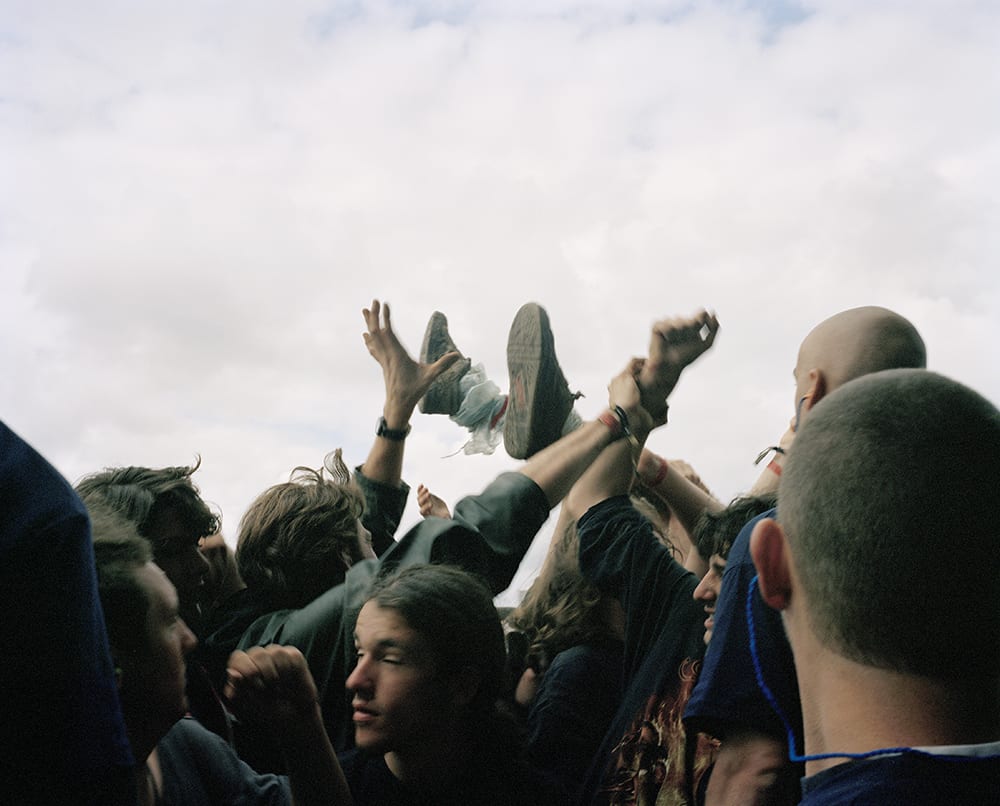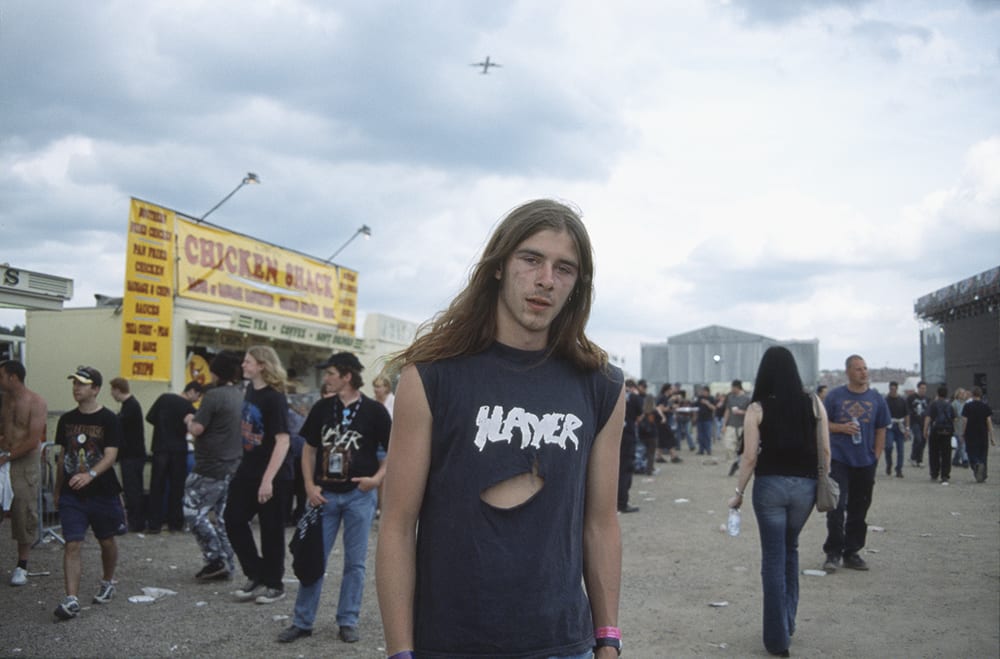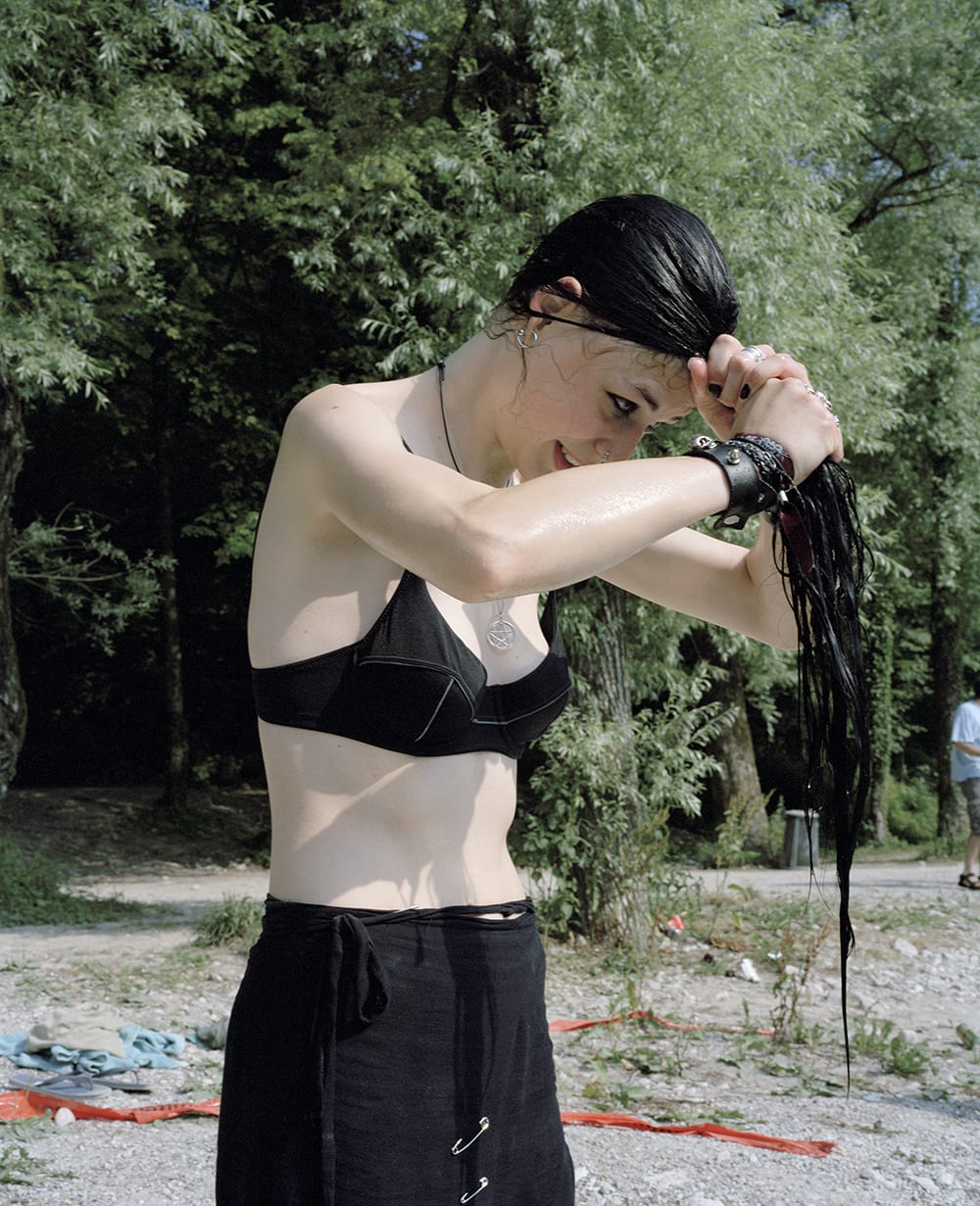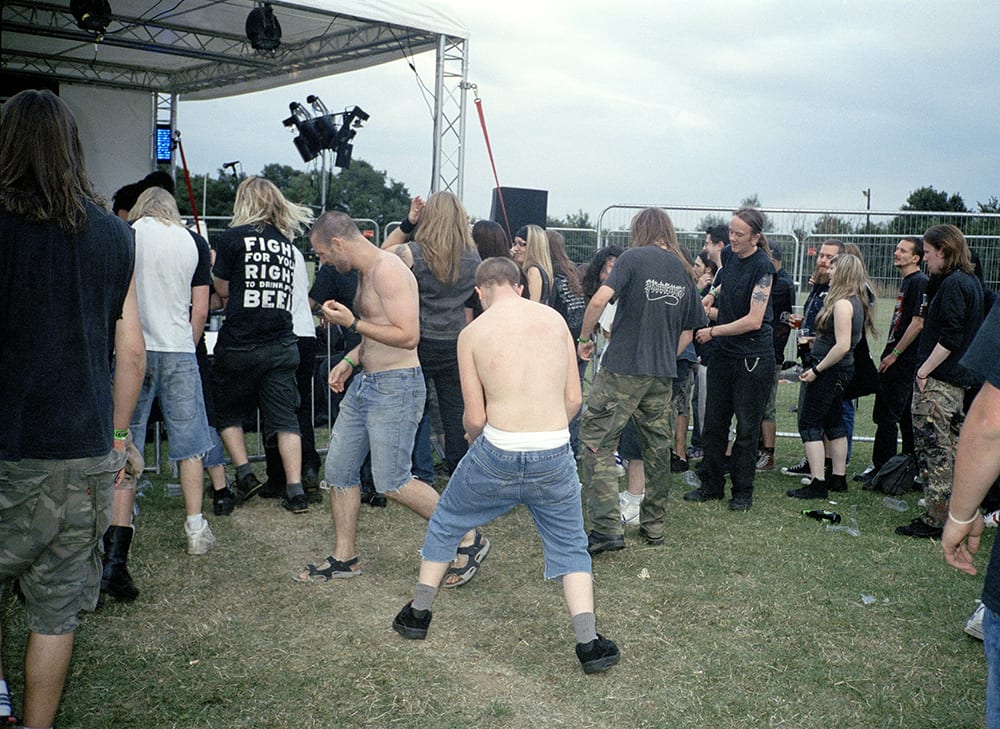Years ago, a goth I knew recounted a conversation he’d once had. “You goths, you’re so desperate to be different but you all look the same,” someone had said to him.
“You don’t get it,” he replied. “We don’t want to be different from each other. We want to be different from you.”
I can’t help but think of this while leafing through God Listens to Slayer, Sanna Charles’s photobook about young Slayer fans, which has just been published by Ditto Press. Whether it’s a sweaty, tangled, mosh pit crowd or a pair of pensive, long-haired kids, what comes across is the sense of community. As my goth friend pointed out, subculture is as much about being an insider as it is about being an outsider.
Charles first saw Slayer perform in 2003, when she was 23 and covering the Download Festival for NME. “It was a really dusty day,” she remembers. “Slayer’s set was put back by three hours and everyone was restless. Not only that, they’d been moved from the main stage to this boiling tent.”
When the band eventually came on, she was blown away. “It was the first time I was seeing a heavy metal pit, which is essentially loads of guys thrashing around, forgetting about everything and focusing on the music,” she says. “It’s a great feeling.”
She filed her pictures to NME but kept returning to some of the portraits she’d taken, and when her friend, the filmmaker Sophie MacCorquodale, said she was looking for a new project, the two decided to try to blag their way on to a Slayer tour. “We had to speak to the manager, Rick Sayles, over the phone from LA,” Charles recalls. “It was scary because I’d never done anything like that before. I think he found the whole thing hilarious.”
When they explained they wanted to shoot the fans, not the band, he said it had already been done, and sent them an American Slayer DVD which featured fans outside shows as one of its extras. “It was really macho and pumped up, with everyone going ‘Slaaaaayer’, so we were like, ‘We don’t want to do that’,” the Brighton photography graduate laughs.
In the end Sayles agreed to give them passes for the Unholy Alliance tour, with certain provisos attached. “He said, ‘Whatever you do, I don’t want to see you backstage at all. Don’t film any of the other bands; in fact, if you turn your camera to the stage you’ll be off.’” Bar a minor misunderstanding with a member of Slipknot – who thought the duo were trying to film them – all went smoothly, across nine UK shows, then a further two in Norway and Finland, where Charles has family.
Back in the UK, MacCorquodale made her documentary, Slayer Rules, and the two put on an exhibition in Shoreditch with some friends. “My dad worked in a repro centre, so he did us some cheap prints and it was a fun party,” says Charles. But exhibiting made her reflect, and she decided she wasn’t finished yet. “I wasn’t that happy with some of the pictures,” she says. “I’d found myself sticking to a formula of straight landscape and portrait shots, and there’s only so much of that you can do before it looks like street style. I wanted to continue building the project – and by then I was really into metal.”
For the next 10 years, Charles followed Slayer fans all over Europe in between, or tacked on to, freelance jobs. Using the same trusty medium format Mamiya 7 II rangefinder she’d had since her student days, plus a 35mm Nikon FE, an Olympus Muji and a Vivitar flash gun when needed, she visited Hellfest in France, Metalcamp in Slovenia and Summer Breeze in Germany, deliberately adopting a looser, more candid style. She also continued to shoot material in fans’ homes, finding subjects through Slayer forums, or through friends she’d met at The Crobar, Soho’s metal haunt. She also shot “loads and loads” of front rows, getting “really obsessed with trying to get people who are stuck in that limbo between absolute joy and absolute pain – elbowed in the ribs but really ecstatic about what they were seeing in front of them”, she says. What’s striking is how little the fans’ appearances change over the decade – so enduring is this scene’s visual culture, that it’s not immediately apparent what’s recent and what’s not. “There’s an element of nostalgia to the scene,” says Charles, but she points out that it has evolved.
“Metal has become more accessible as a whole; it’s promoted in a different way,” she says. “Maybe people have realised that there’s money to be made, so it’s broadened out into mainstream culture. I think people understand that it’s not as scary as it looks and it can actually help with your psyche.”
Charles cites Diane Arbus as an inspiration, along with Glen E Friedman and Karlheinz Weinberger; perhaps unlike Arbus, though, she relates to her subjects with a palpable empathy. Counting herself as a fan just like them, she’s immersed in the scene and their world. “I’ve met some of the most amazing, loving people who are really into Slayer,” she says.
“The music’s so aggressive, but then [you’re at a festival by a lake in Slovenia and] the sun’s out and you’re talking to this crazy Swiss guy in a kilt who’s covered in tattoos of women with their boobs out, and you’re having such a lovely time. That’s the thing about metal – it’s full of these contrasts, so the lyrics are sometimes quite horrific, but then there’s a beauty and a poetry to that.”
By 2013 Charles had accumulated an archive of hundreds of images and had started looking for a publisher. Working with Ben Freeman at Ditto Press on another project, sha.man – which combined a book of Charles’s duotone landscape photographs with a 10-inch vinyl release of two tracks by her band S&M (Sound & Mysticism) – she realised she’d found her collaborator. “Ben took quite a lot of control over the edit, which was helpful,” she says. “Because I’d been sitting with [the project] for so long I found it difficult to make those decisions. He started seeing connections and pulled out images I’d dismissed.”
The result, God Listens to Slayer, is partly inspired by Jouko Lehtola’s Finlandia, a publication Charles really rates. “He’s photographing a subculture, but his subculture is youth,” she says. “Midsummer in Finland is a big deal and kids just take to the streets and the lakes and get shitfaced – it shows this side of Finnish culture that you never see.”
Charles’ book is a similar size, but has a hard cover, she says, and a rougher approach to design. “[Mine has become] something much more fun and relaxed, more like an album that people can relate to in other ways,” she says.
Interviews with fans – including Charles – are printed on brightly coloured paper with serrated edges, and sandwiched between vivid collages of skulls, wolves and other iconic metal objects, or example; in this way Charles and Freeman hope to convey the sense of enthusiasm and shameless abandon, and attract Slayer fans as well as photography buffs. “I love the academic texts you find in photobooks, whereas Ben hates them,” she says. “But I did agree completely with him that this had to appeal to fans of music, as much as fans of photography.”
Charles herself is as serious about her music as her photography, and says this is how she fell into shooting for bands – moving to London after graduating she started photographing the Parkinsons, “a really great Portuguese punk band” and was soon picked up by NME. She now freelances for NME and metal magazines such as Terrorizer and Metal Hammer, and has shot promotional portraits for bands such as Sadistic Goat Torture and Moss. “Living in London, you’d get to know people who were in the scene, so you’d do work for them – album cover type stuff,” she says.
But while classic metal imagery is highly theatrical, her approach has always been more casual. “I’ve never really been into shooting in a studio,” she says. “I like people in a natural environment – whether that’s inside a building or a house or whatever.”
The past five years have seen her explore interests beyond music photography; she’s nearing the end of an MA in art and design in education at UCL Institute of Education, an experience that’s taken her work in a more political direction. Her final piece, Beating the Bounds, was inspired by anarchist social historian Colin Ward and sets moving images to oral histories about her home borough, Waltham Forest. Next she plans to make a film in her mother’s native Finland. But music, photography and the connection between the two are still fundamental to her creative output. “It’s something I’m always working on,” she says. “Whether that’s making music myself and attempting to visualise it through photography, or using photography as a means to complement or create meaning from music.”
God Listens to Slayer by Sanna Charles is published by Ditto Press, priced £25
sannacharles.tumblr.com




